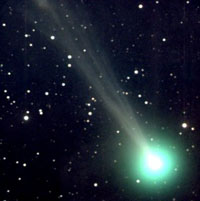Orionid Meteor Shower Peaks Tonight
The Orionid meteor shower, a trail of debris left in space by Halley's Comet, was at its most intense in the early hours of Wednesday.

Experts were expecting to see dozens of meteors an hour in some places as the shower approached its peak this morning.
The annual Orionid shower, so-called because it appears from the direction of the constellation Orion, is created when earth passes through trails of debris floating through space.
It is visible from almost anywhere in the world, because Orion - "the hunter" - is on a sight line very close to the equator, but the best viewing is found in rural areas away from light pollution, Telegraph.co.uk reports.
The best time to watch will be between 1 a .m. and dawn local time Wednesday morning, regardless of your location. That's when the patch of Earth you are standing on is barreling headlong into space on Earth's orbital track, and meteors get scooped up like bugs on a windshield.
Peak activity, when Earth wades into the densest part of the debris, is expected around 6 a .m. ET.
Some meteors could show up late tonight, too. Late-night viewing typically offers fewer meteors, however, because your patch of Earth is positioned akin to the back window of the speeding car.
The Orionids have been strong in recent years.
"Since 2006, the Orionids have been one of the best showers of the year, with counts of 60 or more meteors per hour," Cooke said, FOX News reports.
The Orionids are so named because the meteors appear to radiate from near the constellation Orion, aka the Hunter.
This easily spotted constellation "kind of looks like an hourglass with a very recognizable belt of stars," said astronomer Mark Hammergren of the Adler Planetarium in Chicago .
In addition, "the constellation is visible from pretty much anywhere in the world, because it appears along a line of sight close to the Equator," he said, National Geographic News reports.
Subscribe to Pravda.Ru Telegram channel, Facebook, RSS!


